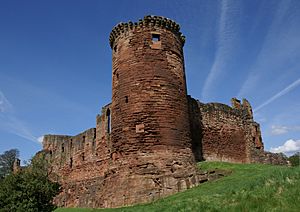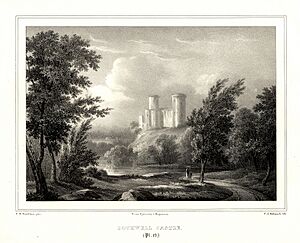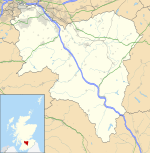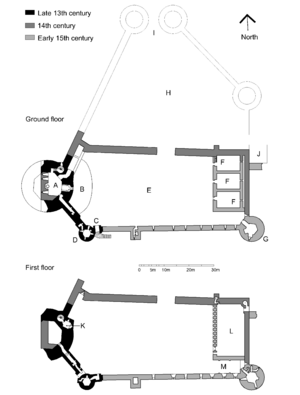Bothwell Castle facts for kids
Quick facts for kids Bothwell Castle |
|
|---|---|
| Bothwell, South Lanarkshire, Scotland grid reference NS688593 |
|

South-east tower of the castle
|
|
| Coordinates | 55°48′34″N 4°05′42″W / 55.8094549°N 4.0950432°W |
| Type | Castle of enceinte |
| Site information | |
| Owner | Historic Environment Scotland |
| Controlled by | De Moravia family England Earl of Douglas Earl of Angus |
| Open to the public |
Yes |
| Condition | Ruined |
| Site history | |
| Built | Begun 13th century |
| Built by | Walter de Moravia |
| Materials | Coursed red sandstone rubble |
Bothwell Castle is a big, old castle from the Middle Ages. It sits high up on a steep bank next to a bend in the River Clyde in South Lanarkshire, Scotland. You can find it between the towns of Bothwell and Uddingston, about 16 kilometers (10 miles) south-east of Glasgow. People started building it in the 1200s. The ancestors of Clan Murray began its construction to protect an important place where people could cross the River Clyde. Bothwell Castle was very important during Scotland's Wars of Independence. It was captured and recaptured many times.
The castle's huge round tower, called a donjon, was built in the 1200s. However, before the rest of the castle was finished, it was badly damaged during several sieges. The castle was rebuilt in the early 1400s and became much larger. But by the 1700s, people had stopped using it. Today, the castle is a ruin. It has a rectangular shape, with the remains of the donjon on the west side. The Great Hall, a large meeting room, is on the east side. Long curtain walls surround the courtyard. There are also round towers at the south-east and south-west corners. A Scottish archaeologist named William Douglas Simpson said Bothwell Castle was one of the most important old buildings in Scotland from the Middle Ages.
Contents
History of Bothwell Castle
Early Days and Construction
Around the mid-1100s, King David I gave the land of Bothwell to David Olifard. Later, by 1252, the land belonged to Walter of Moray. He started building the castle. However, when the Wars of Scottish Independence began in 1296, only the main donjon (the big round tower), the prison tower, and a short connecting wall were finished. The foundations for the rest of the castle were probably in place. These parts would have been protected by a wooden fence called a palisade.
Bothwell Castle in the Wars of Independence
When King Edward I of England invaded Scotland at the start of the war, his forces took Bothwell Castle. At this time, William Moray of Bothwell held the castle. The English soldiers guarding the castle were surrounded by the Scots for 14 months, from 1298 to 1299. Eventually, the English gave up.
King Edward I returned in 1301. He captured the castle again with a large army of 6,800 men. He even used special siege engines to help him. Bothwell Castle then became the main base for Aymer de Valence, 2nd Earl of Pembroke, who was Edward's chosen leader in Scotland. The English held the castle for several years.
After Robert the Bruce won the Battle of Bannockburn in 1314, Bothwell Castle offered safety to some English nobles. However, the castle's leader, Sir Walter FitzGilbert, surrendered the castle to the Scottish army that was approaching. Because of this, he was given the land of Cadzow. His family later became the powerful Clan Hamilton. After the castle was surrendered, the Scots deliberately damaged it so the English could not use it again. This is called slighting.
In 1336, the English came back again, this time led by Edward III. The English king had the castle repaired and made it his main base in Scotland once more. However, the next year, Sir Andrew Murray recaptured the castle. He was the rightful owner of Bothwell and used siege engines again. After his victory, he damaged the castle once more. He pulled down the west side of the donjon, letting it fall into the River Clyde. This was to make sure the enemy could not use it again. The castle remained in ruins until the 1360s.
The Douglas Family Takes Over
In 1362, Joan Moray of Bothwell, who inherited the Moray family's lands, married Archibald Douglas. He was known as "the Grim" and later became a powerful Scottish lord. Douglas started rebuilding Bothwell Castle. He repaired the donjon and finished the walls. His son, Archibald, the 4th Earl, continued the work. By 1424, they had built the Great Hall and a nearby chapel. They also added towers at the north-east and south-east corners. Curtain walls connected these parts to the donjon, creating a large enclosed courtyard.
The "Black" Douglas family lost their lands in 1455, and the castle went back to the Scottish crown. King James III gave Bothwell to Lord Crichton, and then to Sir John Ramsay. Both of them lost the castle in turn. In 1488, Bothwell was given to Patrick Hepburn. He was made the Earl of Bothwell. However, Hepburn did not keep Bothwell Castle for long. He traded it with Archibald Douglas, 5th Earl of Angus, known as "Bell-the-Cat," for Hermitage Castle. King James IV visited Bothwell in 1503 and 1504.
Bothwell Castle then returned to the Douglas family. It passed down through the Earls of Angus and Marquesses of Douglas to the Earls of Forfar. Archibald Douglas, 1st Earl of Forfar, started building a new house nearby. He even took stones from the castle's north-east tower to use for his new home. (His house was later taken down in 1926 because the ground underneath it was sinking due to mining.) After the 2nd Earl of Forfar died in 1715, the castle went back to the main Douglas family line. This was represented by the 1st Duke of Douglas and his family. The castle then passed to the Earls of Home. In 1935, the 13th Earl gave Bothwell Castle to the care of the state.
Today, Historic Environment Scotland manages Bothwell Castle. It is a scheduled monument, which means it is a nationally important historical site. The castle was open to the public with an admission fee until 2020. It was closed then because of safety concerns.
Castle Design and Features

Bothwell Castle was never fully completed to its original plan. However, its design is similar to other strong castles like Coucy, Kildrummy, and Dirleton. This is because it has a round tower, or donjon. The donjon is now in ruins, but it was originally about 25 meters (82 feet) high and 19 meters (62 feet) across. Its walls were very thick, about 4.5 meters (15 feet) thick. Later, even thicker walls and a strong gatehouse were added to the castle. Because of these features, Bothwell Castle was considered one of the most important military strongholds in Scotland.





